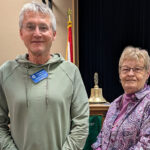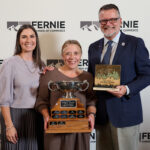Home »

East Kootenay Invasive Plant Council targets Leafy Spurge
The East Kootenay Invasive Plant Council (EKIPC) has put Leafy Spurge (Euphorbia esula) in its sight with the hopes of substantially reducing this harmful species.
 “Leafy Spurge is one weed that we don’t want expanding its territory in the East Kootenay,” EKIPC coordinator Marty Hafke states. “Not only can it impact native grasslands and ecosystems but studies from Manitoba have shown that it reduces productivity, income and ultimately land values in areas where it is not controlled.”
“Leafy Spurge is one weed that we don’t want expanding its territory in the East Kootenay,” EKIPC coordinator Marty Hafke states. “Not only can it impact native grasslands and ecosystems but studies from Manitoba have shown that it reduces productivity, income and ultimately land values in areas where it is not controlled.”
Leafy Spurge is considered to be one of the top 100 worst invasive alien species on the planet and for obvious reasons, is classed as a noxious weed within British Columbia. Its ability to out compete native vegetation has caused millions of dollars in damage to economic and recreational interests across the globe and has significantly reduced biodiversity.
There is not a lot of Leafy Spurge in B.C., but what we do have is mostly found in the Columbia Valley. Not the sort of recognition you would want!
Anecdotal reports suggest that there was no Leafy Spurge in the area until the 1960s. By accident, some hay contaminated with Leafy Spurge was brought in from elsewhere and shortly thereafter, the species began to spread. Both sides of the Columbia Valley between Invermere and Radium are now infested with the plant on both private and Crown land. It is now appearing in the Columbia wetlands, an area recognized internationally for its ecological importance.
Previous efforts by private landowners and agencies to tackle the problem have had varying results. Leafy Spurge can be successfully controlled, but a coordinated effort is needed.
Through EKIPC’s Strategic Invasive Plant Control of Leafy Spurge (SIPCOLS) program, it was decided to initially focus in controlling this species locally on the west side of the Columbia Valley. The Leafy Spurge is still somewhat contained on a small number of properties in this area and treatments by the Ministry of Forests in years past have kept the plant from expanding too far.
The landowners on the west side of the Columbia Valley were approached to enroll in the Neighborhood Invasive Plant Program (NIPP) where technical and financial support would be provided to help treat the Leafy Spurge on private lands. In a matter of days, all the landowners were on board to work together to combat Leafy Spurge.
The next priority was to treat the adjoining Crown land and Columbia wetlands. Research shows that a consistent and effective treatment regime on Leafy Spurge is essential. Now that the private landowners were working together and showing great results, the Crown land base needed the same effort.
The EKIPC applied to and received funding from the Columbia Valley Local Conservation Fund (CVLCF), which is funded by the RDEK. The fund was already supporting the Neighborhood Invasive Plant Program and now, with a small investment on the ‘other side of the fence,’ the entire land base is now being treated. Essentially, CVLCF funding will protect the investments private landowners are making while also allowing for more targeted treatments on the Crown land Leafy Spurge infestations.
The geographical focus on Leafy Spurge, regardless of jurisdiction, is essential in making positive change with this plant. Private land treatments started in 2010, followed by Crown land treatments in 2011. Results have been impressive to date as the Crown land has seen a reduction of area covered by Leafy Spurge of 50%.
The plan is to keep the foot on the pedal with the Leafy Spurge treatments for five years. After five years, EKIPC hopes to have it well under control and then shift to maintenance treatments. Based on the results in the first couple of years, we hope to see very little Leafy Spurge by then! The EKIPC will then set its sights on Leafy Spurge infestations on the east side of the valley in 2016.
None of this would be possible without the financial support by the Local Conservation Fund, Columbia Basin Trust and the Province of B.C. Thanks to their support, we are making a difference.
Dave Hillary, the program manager for the Kootenay Conservation Program, sums it up like this: “The Kootenay Conservation Program, which administers the Columbia Valley Local Conservation Fund (CVLCF), is very pleased to support the ongoing work of the East Kootenay Invasive Plant Council. Their work to prevent the spread of invasive species is focused, prioritized, coordinated, and their success is measurable.”
If you would like more information about the East Kootenay Invasive Plant Council, or if your group or individual is interested in joining the Council, you can contact Marty Hafke, EKIPC Coordinator at 1-888-55-EKIPC.
Submitted







